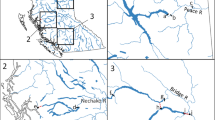Abstract
Lakes Manapouri and Te Anau, in Fiordland National Park, became the center of a major controversy after the New Zealand government offered their water resource to an overseas aluminum smelting consortium for electricity generation. Although the scheme proceeded, the lake levels were not raised as originally proposed. Rather, government sought guidelines to optimize hydroelectric potential while maintaining ecological stability of the vulnerable, largely forested, glaciated lakeshores. Guidelines were derived by relating the vegetation zonation to the natural lake-level fluctuations recorded daily for 37 years. Ahigh operating range in the upper third of the lakes' natural ranges, based on flood tolerances of the woody shoreline species, restricts both duration and frequency. Alow operating range (ca. lower third) safeguards stability of shoreline sediments by limiting drawn-down rates, duration, and frequency. Themain operating range (ca. middle third) has few limitations. These guidelines, which allow utilization of ca. 93% of the water resource, have now been verified by instances of flooding and draw-down rates that exceeded the natural rates recorded earlier. The guidelines were officially accepted by the government in 1977 as a basis for managing the valuable multiple resources of these two lakes and their environs, and they were formalized in legislation in 1981. The details and merits of the guideline approach are discussed.
Similar content being viewed by others
Literature cited
Allan, H. H. 1961. Flora of New Zealand, vol. 1. Government Printer, Wellington. 1085 pp.
Andrews, P. B., and I. C. McKellar. 1973. Lake Manapouri: shoreline stability and the effects of lowered lake levels. Unpublished report, Geological Survey, New Zealand Department of Scientific and Industrial Research.
Cabinet Committee on Lake Manapouri. 1970. Report of the cabinet committee on Lake Manapouri. Government Printer, Wellington. 79 pp.
Johnson, P. N. 1972a. Applied ecological studies of shoreline vegetation at Lakes Manapouri and Te Anau, Fiordland. 1. Vegetation of Lake Manapouri shoreline.Proceedings of the New Zealand Ecological Society 19:102–119.
Johnson, P. N. 1972b. Applied ecological studies of shoreline vegetation at Lakes Manapouri and Te Anau, Fiordland. 2. The lake edge flora: habitats and relations to lake levels.Proceedings of the New Zealand Ecological Society 19:120–142.
Mark, A. F. 1972. Applied ecological studies of shoreline vegetation at Lakes Manapouri and Te Anau: general introduction.Proceedings of the New Zealand Ecological Society 19:100–101.
Mark, A. F. 1985, Manapouri: a case study in nature conservation in New Zealand. Chapter 18in P. R. Dingwall and L. F. Molloy (eds.), Nature conservation in New Zealand. Price Milburn, Wellington (in press).
Mark, A. F., J. R. Crush, and C. D. Meurk. 1972. Applied ecological studies of shoreline vegetation at Lakes Manapouri and Te Anau, Fiordland. 3. Vegetation of the Lake Te Anau shoreline.Proceedings of the New Zealand Ecological Society 19:143–154.
Mark, A. F., and P. N. Johnson. 1972. Applied ecological studies of shoreline vegetation at Lakes Manapouri and Te Anau, Fiordland. 4. Recommendations.Proceedings of the New Zealand Ecological Society 19:155–157.
Mark, A. F., P. N. Johnson, and J. B. Wilson. 1977. Factors involved in the recent mortality of plants from forest and scrub along the Lake Te Anau shoreline.Proceedings of the New Zealand Ecological Society 24:34–42.
McKellar, I. C. 1974. Te Anau lakeshore beach sediments. Unpublished report, Geological Survey, New Zealand Department of Scientific and Industrial Research.
Moore, L. B., and E. Edgar. 1970. Flora of New Zealand, vol. 2. Government Printer, Wellington. 354 pp.
Nature Conservation Council. 1981. Integrating conservation and development: a proposal for a New Zealand conservation strategy. Nature Conservation Council, Wellington. 63 pp.
Pickrill, R. A. 1976. Lacustrine geomorphology of Lakes Manapouri and Te Anau. Unpublished PhD thesis, University of Canterbury. 402 pp.
Pickrill, R. A. 1978a. Beach and nearshore morphology of Lakes Manapouri and Te Anau, New Zealand: natural models of a continental shelf.New Zealand Journal of Geology and Geophysics 21:229–242.
Pickrill, R. A. 1978b. Effects of boat wakes on the shoreline of Lake Manapouri.New Zealand Engineering 33:194–198.
Author information
Authors and Affiliations
Rights and permissions
About this article
Cite this article
Mark, A.F., Johnson, P.N. Ecologically derived guidelines for managing two New Zealand lakes. Environmental Management 9, 355–363 (1985). https://doi.org/10.1007/BF01867306
Issue Date:
DOI: https://doi.org/10.1007/BF01867306




